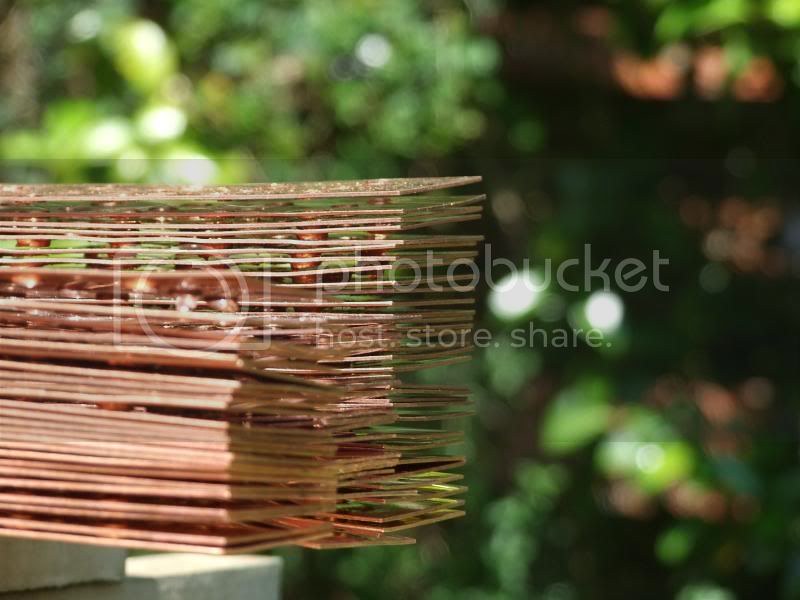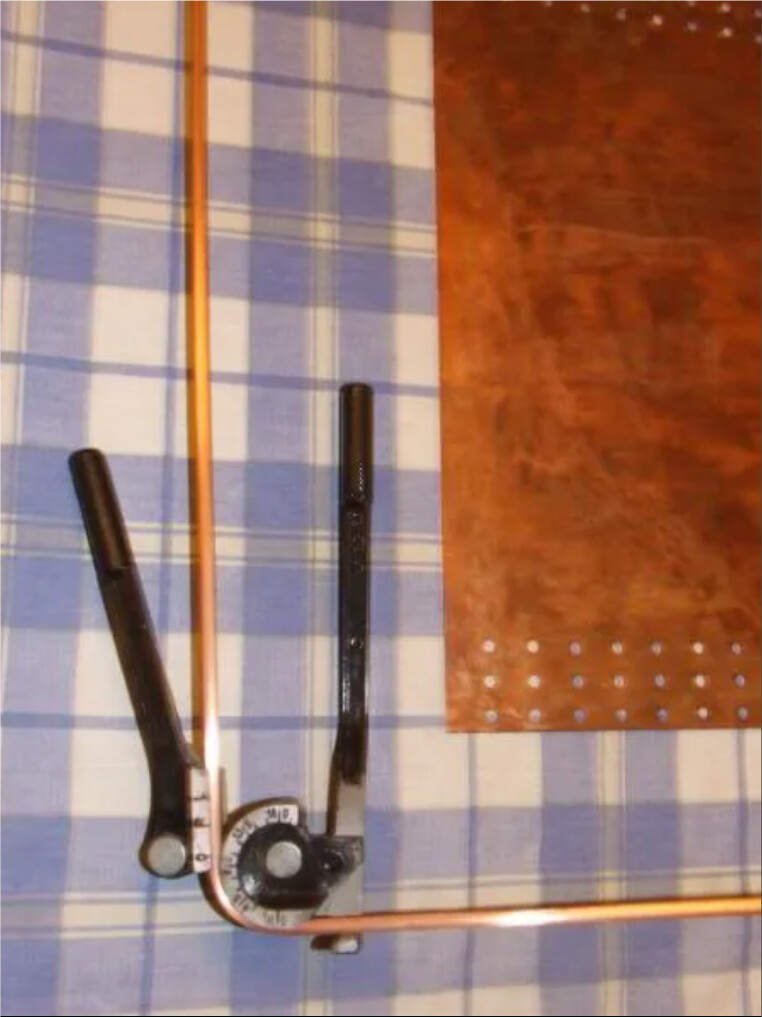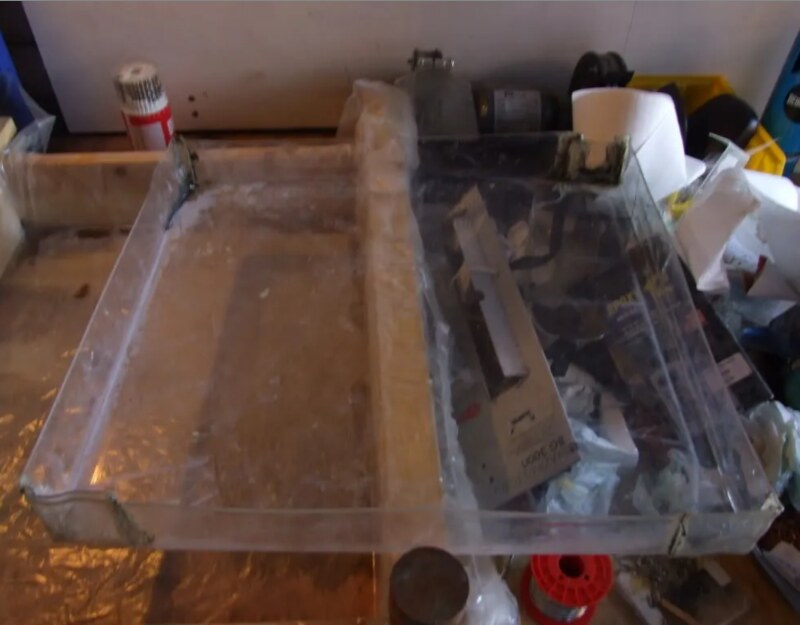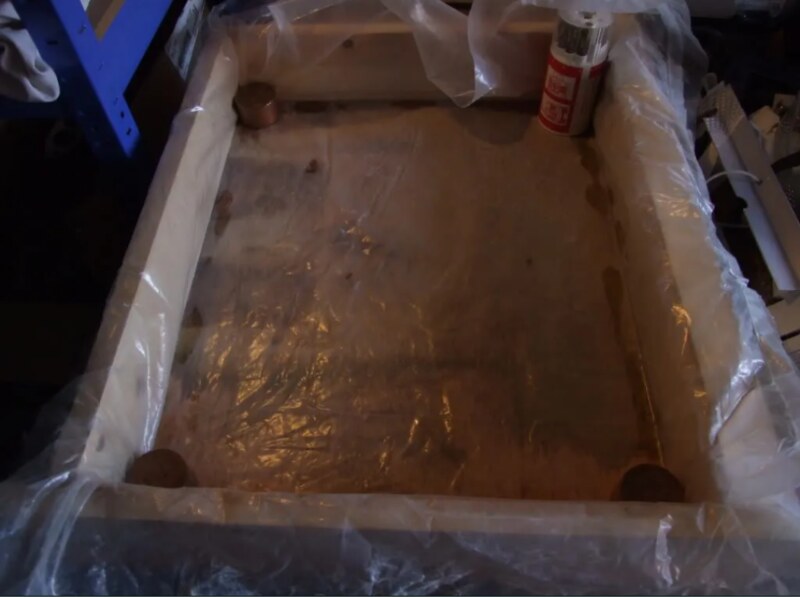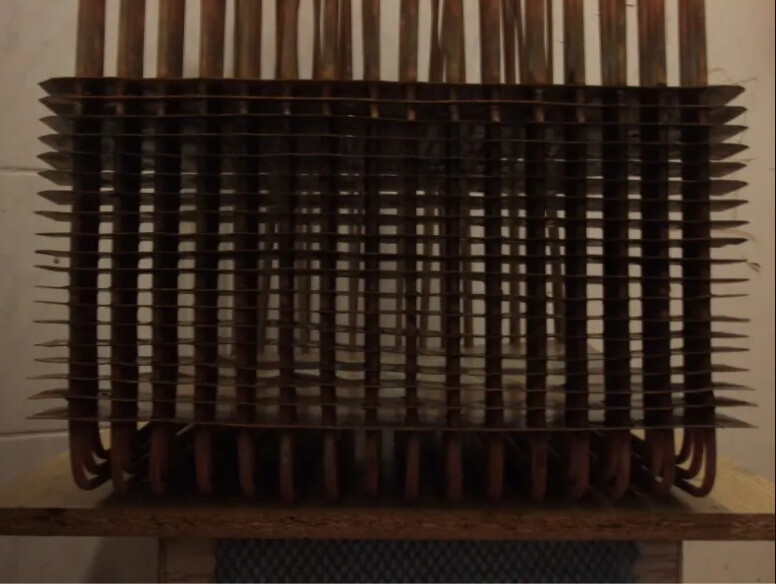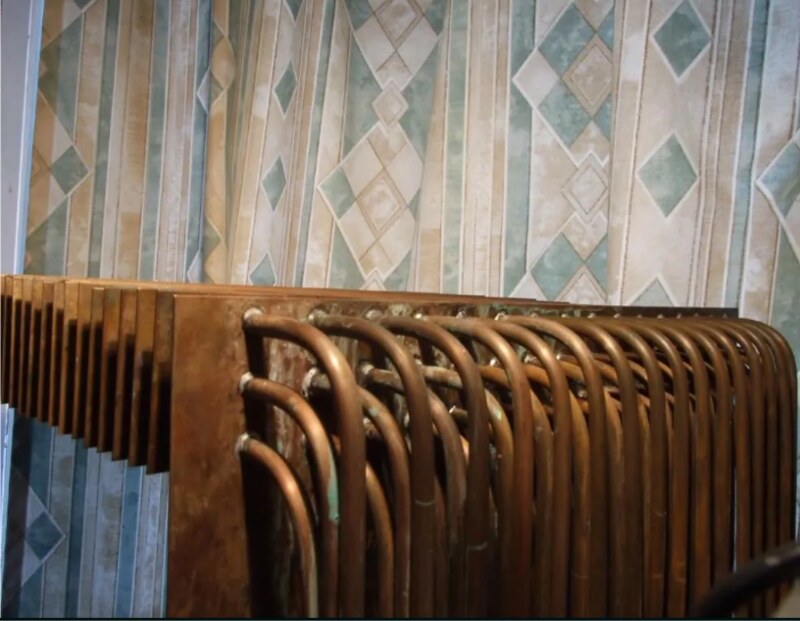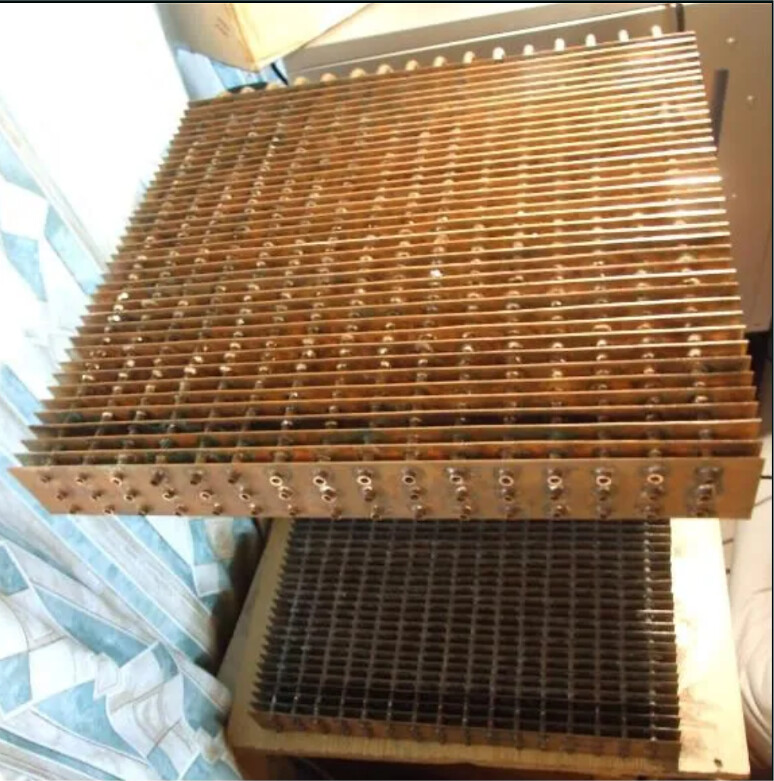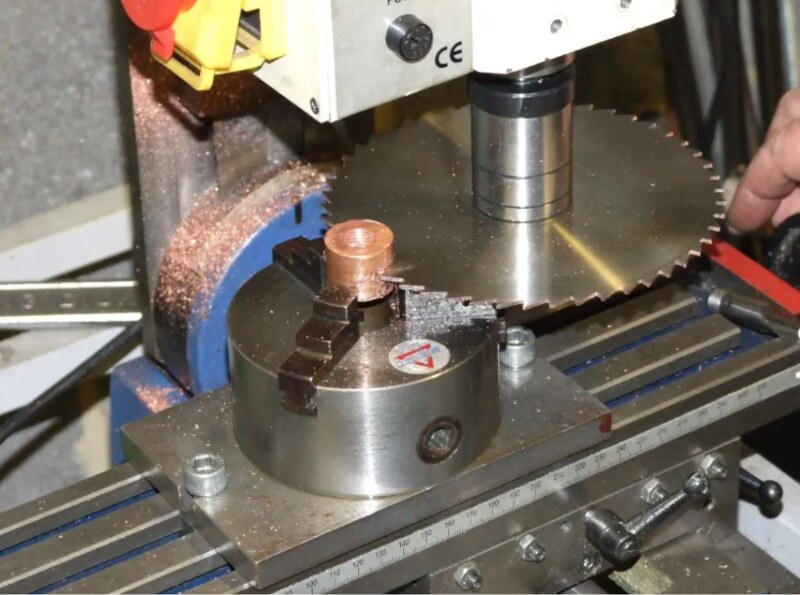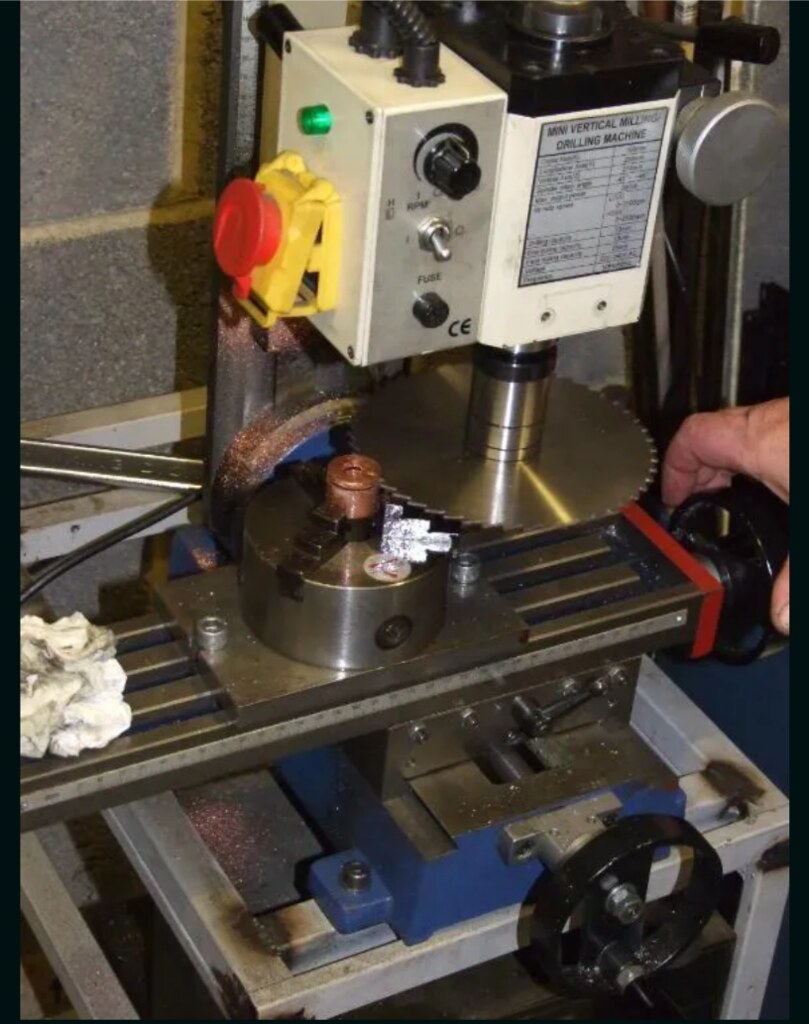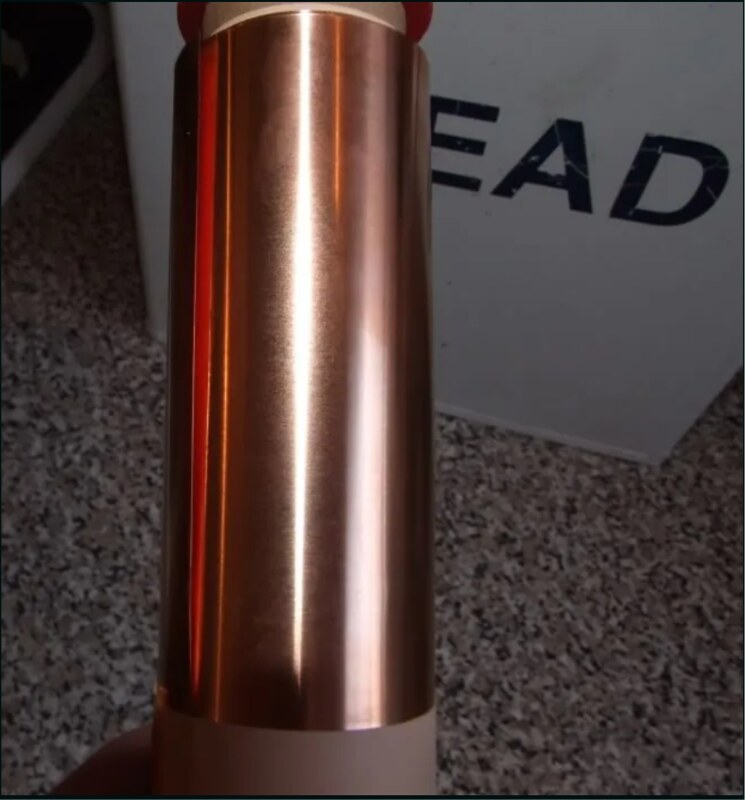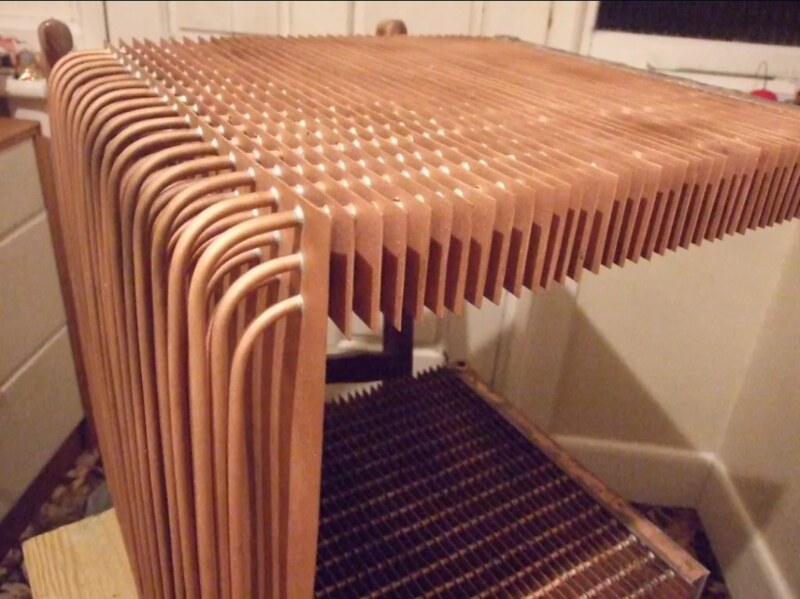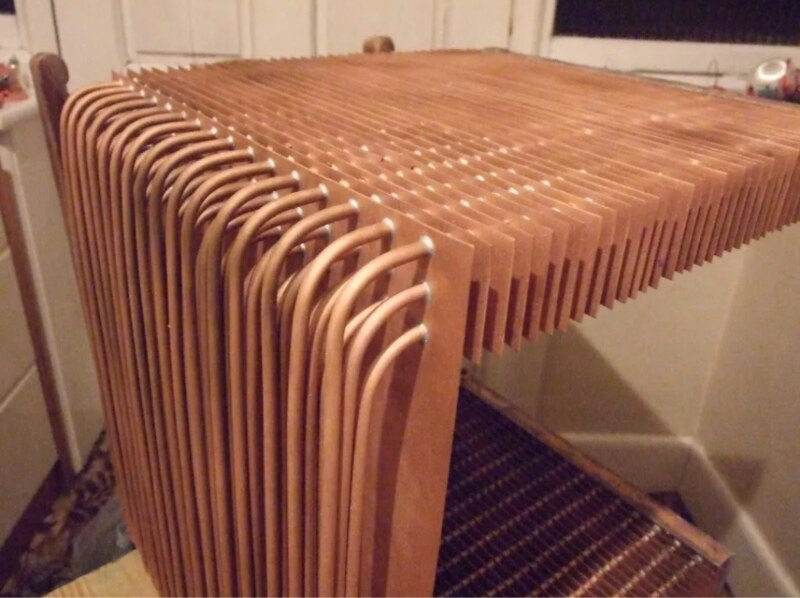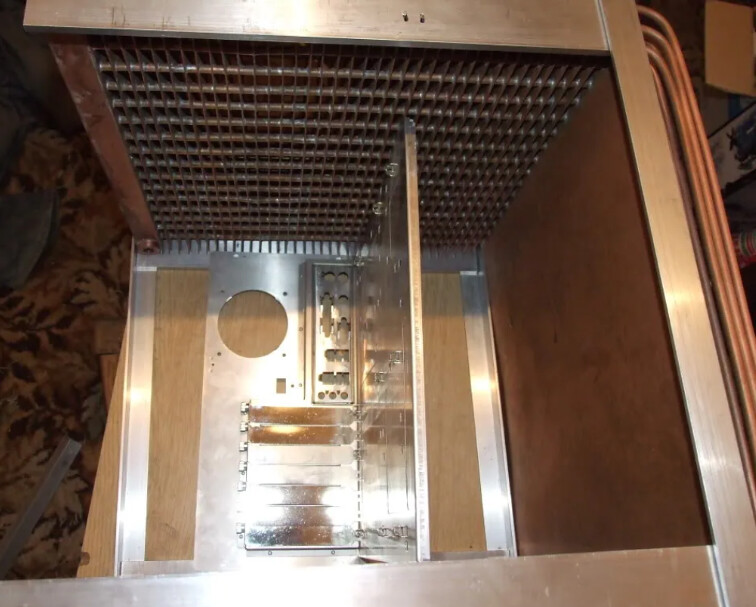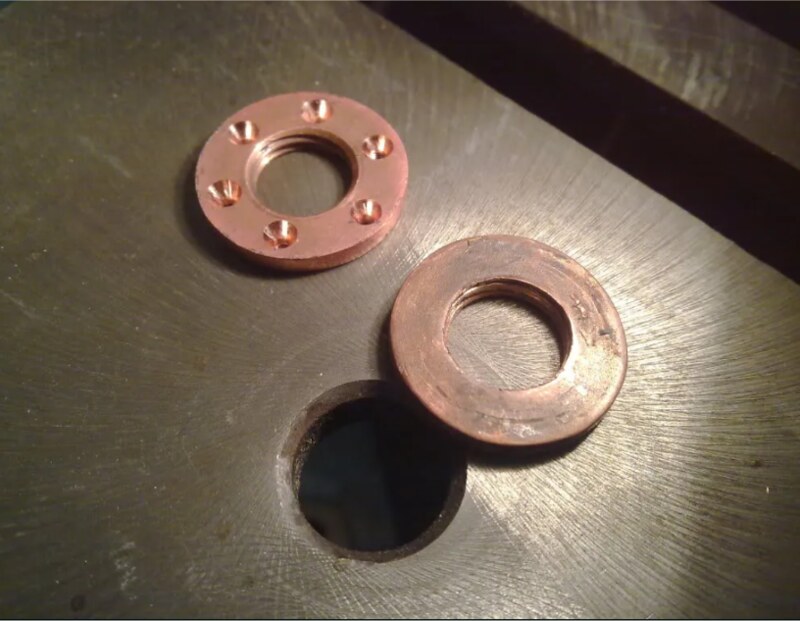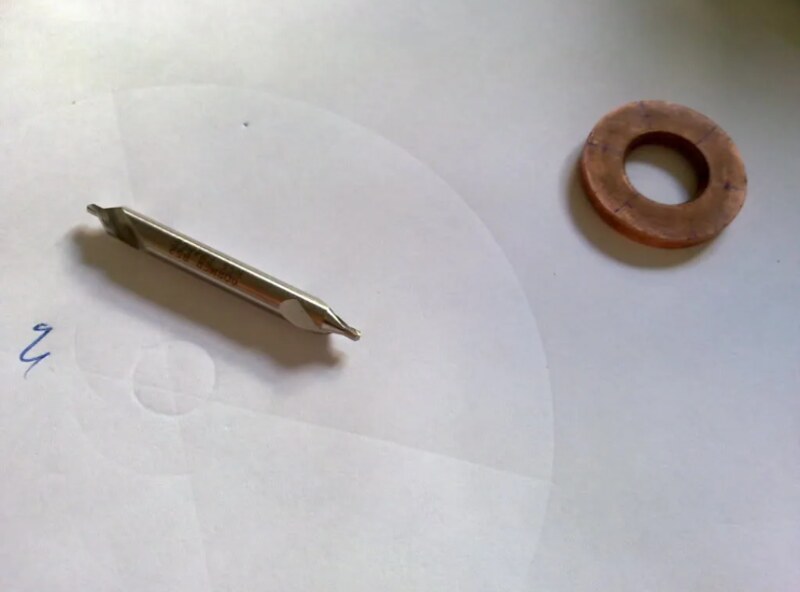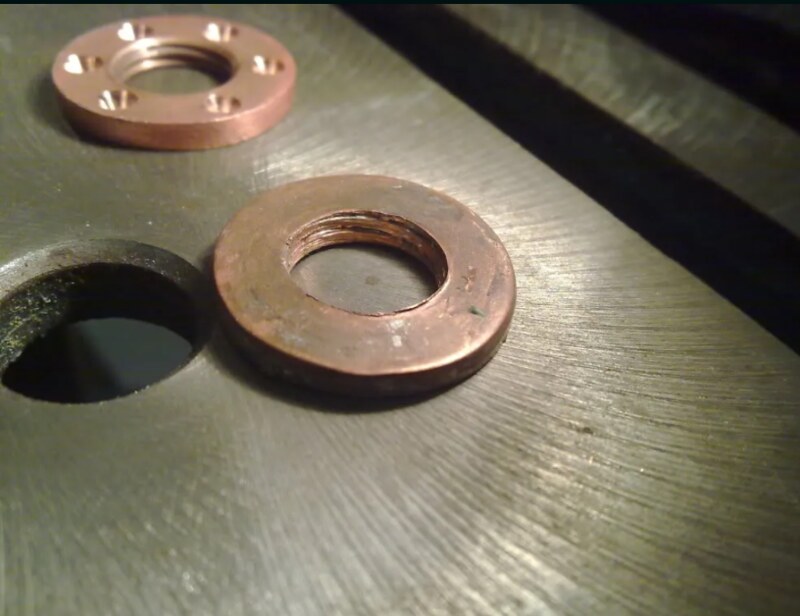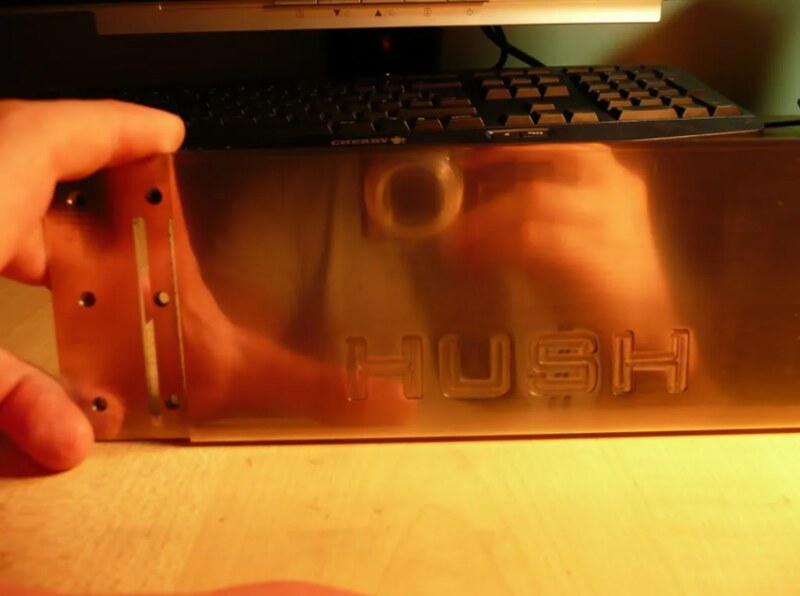Monkey Puzzle
Member

Greetings everyone! This is a project that was originally started back in 2009. It was got to a functional working state, with PC components installed, but then life got in the way before completing it... I was moving around the country at least annually for work, and the case got put in storage. Over the last year I have been finishing it...
A big thank you to Alphacool (and to Christopher at Alphacool) for kindly offering to sponsor the project!
Well, here's the build logs so far, starting from the beginning.. This might take a while! I will post the progress so far, adding more posts of the build over the coming days, so please do come back to read more!
------
July 2009:
Hello all. I've started making a large passive radiator/case. I've been working on it for a while, but since the design is quite complicated I thought I'd wait until it got to a recognisable, likely to work(!) stage before starting the build log.
I have had an innovatek Konvekt-o-matik before selling it on members' market, but from what I've heard you really need a shedload of them to handle high heatloads. Plus, they're expensive (~£80/6tubes), bulky and the design is flawed in my opinion - aluminium, made for 8mm ID tubing, and by their design the more of them you add the larger the pressure loss - 8mm inlet splits to 8mm tubes running in parallel.
So I figured I'd make my own;

copper,
designed for 7/16" or 1/2" tubing,
minimise pressure loss by matching resistance of the tubes to 1/2" tubing,
massive amount of surface area (since it's the equivalent of an Aga it needs to have headway for extra heatload),
wide fin spacing and compact enough to be self-contained within a case.
The case is going to be approximately 45cm wide x 40cm deep x 46cm tall + height of castors. So it's slightly smaller than a mountain mods UFO (45x45x45)
The top, far side of the case (the non-window side panel on a normal case) and the bottom will be made up of a large finned copper radiator, hopefully with enough surface area and passive airflow to run completely passive, with air rising up through the case.
 I wish I was competent enough with google sketchup to draw a detailed plan, but it just seems a nightmare because of the design, so I'm afraid I've largely stuck to hand-drawn sketches. Here's a very rough idea of what the passive radiator element of the case will look like.
I wish I was competent enough with google sketchup to draw a detailed plan, but it just seems a nightmare because of the design, so I'm afraid I've largely stuck to hand-drawn sketches. Here's a very rough idea of what the passive radiator element of the case will look like.
 d5c1101c by Tom ., on Flickr
d5c1101c by Tom ., on Flickr
Initially I was going to use 30 metres of standard 15mm outer diameter half-hard pipe used in home plumbing and flatten it as in normal watercooling radiators, but after buying a small sample (a gentle elbow bend) and trying to flatten it I realised it's very tricky to get an even inner channel, and it would take forever to flatten 30m of the half-hard stuff...
 7f68d996 by Tom ., on Flickr
7f68d996 by Tom ., on Flickr
 87d66dc2 by Tom ., on Flickr
87d66dc2 by Tom ., on Flickr
After scouring around to find a cheap source of soft copper pipe I found on ebay what was listed as 9m of soft 15mm outer diameter, 0.4mm-thick-walled copper pipe used as gas lines in boats and motorhomes, and being the only bidder got it dirt cheap.
 . I picked up an adjustable pipe cutter (3-22mm) for a few quid and measured and cut 130cm lengths. Turns out I was sold around 14m, so had 10 x 130cm, and an offcut.
. I picked up an adjustable pipe cutter (3-22mm) for a few quid and measured and cut 130cm lengths. Turns out I was sold around 14m, so had 10 x 130cm, and an offcut.
Unfortunately, though slightly easier than the the half-hard copper, the walls of the stuff I got was 1.5mm so it was still a nightmare, and still came out uneven in cross-section and took ages to flatten. I also found it's expensive stuff to get any more - about £80 for 25m. I'll find a good use for it later on though.
 22168a7d by Tom ., on Flickr
22168a7d by Tom ., on Flickr
So, time for plan B. I managed to find a site selling 10m x 6mm outer diameter, 4.8mm inner diameter soft microbore copper tubing, so I picked up 6 rolls for ~£42 inc p&p
 538124f2 by Tom ., on Flickr
538124f2 by Tom ., on Flickr
 cd85c9a3 by Tom ., on Flickr
cd85c9a3 by Tom ., on Flickr
I then unrolled them, measured and cut into 48 lengths - 16 x 120cm, 16 x 125cm and 16 x 130cm - the difference is because the 48 tubes will be arranged as so, so the outer tubes need to be a bit longer:
 1255a9c7 by Tom ., on Flickr
1255a9c7 by Tom ., on Flickr
 a330a423 by Tom ., on Flickr
a330a423 by Tom ., on Flickr
 3333fbf0 by Tom ., on Flickr
3333fbf0 by Tom ., on Flickr
The microbore copper is so soft it's very easy to bend and straighten, though it's tricky to get 130cm lengths completely straight. It work-hardens and quickly becomes difficult to bend, though it can be annealed again by sticking it over a gas hob.
Anyhow, I had originally planned to use some of the 15mm pipe I had for the end pipes distributing the water to the 6mm copper tubes. It has a 12mm inner diameter so is a pretty good match for either 7/16" or 1/2" tubing.. After straightening one of the 130cm lengths I bent it to a hook shape over a rolling pin, which was quite tricky. I then cut it to a rough length and measured out the 48 x 6mm holes for the microbore pipe to connect to.
The pipes will have to do a bit of bending at the ends, but hopefully with the small bore pipebender I got this won't be too much trouble, though in reality it'll probably be very very frustrating, since the pipe needs to be bent after the copper fins have been pushed into place.
After lots and lots of drilling here are the radiator end pieces. This would have been so much easier if I had a bench drill and a vice, but as I didn't at this stage I had to improvise:
 41c5ba2f by Tom ., on Flickr
41c5ba2f by Tom ., on Flickr
 b918967b by Tom ., on Flickr
b918967b by Tom ., on Flickr
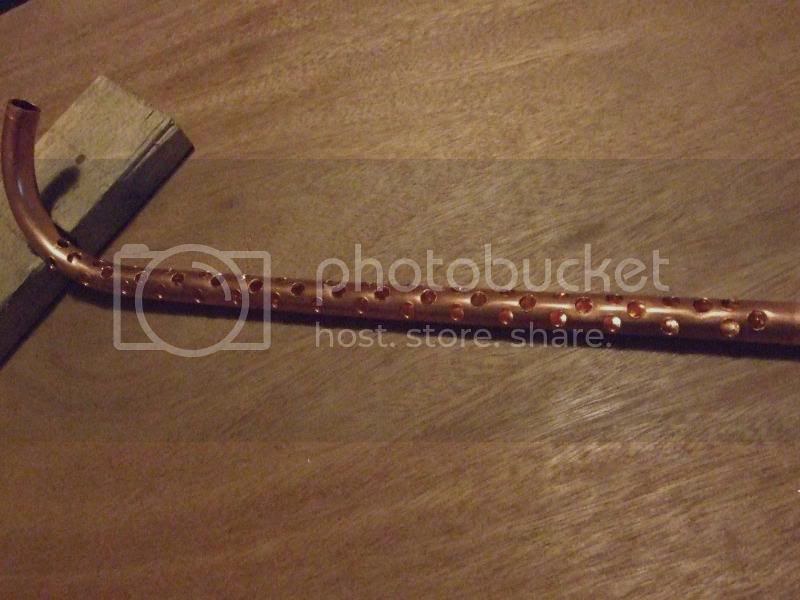 a7cae1ed by Tom ., on Flickr
a7cae1ed by Tom ., on Flickr
Plan for pipes joining distributor end tube - side view
 03be0139 by Tom ., on Flickr
03be0139 by Tom ., on Flickr
A big thank you to Alphacool (and to Christopher at Alphacool) for kindly offering to sponsor the project!
Well, here's the build logs so far, starting from the beginning.. This might take a while! I will post the progress so far, adding more posts of the build over the coming days, so please do come back to read more!
------
July 2009:
Hello all. I've started making a large passive radiator/case. I've been working on it for a while, but since the design is quite complicated I thought I'd wait until it got to a recognisable, likely to work(!) stage before starting the build log.
I have had an innovatek Konvekt-o-matik before selling it on members' market, but from what I've heard you really need a shedload of them to handle high heatloads. Plus, they're expensive (~£80/6tubes), bulky and the design is flawed in my opinion - aluminium, made for 8mm ID tubing, and by their design the more of them you add the larger the pressure loss - 8mm inlet splits to 8mm tubes running in parallel.
So I figured I'd make my own;

copper,
designed for 7/16" or 1/2" tubing,
minimise pressure loss by matching resistance of the tubes to 1/2" tubing,
massive amount of surface area (since it's the equivalent of an Aga it needs to have headway for extra heatload),
wide fin spacing and compact enough to be self-contained within a case.
The case is going to be approximately 45cm wide x 40cm deep x 46cm tall + height of castors. So it's slightly smaller than a mountain mods UFO (45x45x45)
The top, far side of the case (the non-window side panel on a normal case) and the bottom will be made up of a large finned copper radiator, hopefully with enough surface area and passive airflow to run completely passive, with air rising up through the case.

 d5c1101c by Tom ., on Flickr
d5c1101c by Tom ., on FlickrInitially I was going to use 30 metres of standard 15mm outer diameter half-hard pipe used in home plumbing and flatten it as in normal watercooling radiators, but after buying a small sample (a gentle elbow bend) and trying to flatten it I realised it's very tricky to get an even inner channel, and it would take forever to flatten 30m of the half-hard stuff...
 7f68d996 by Tom ., on Flickr
7f68d996 by Tom ., on Flickr 87d66dc2 by Tom ., on Flickr
87d66dc2 by Tom ., on FlickrAfter scouring around to find a cheap source of soft copper pipe I found on ebay what was listed as 9m of soft 15mm outer diameter, 0.4mm-thick-walled copper pipe used as gas lines in boats and motorhomes, and being the only bidder got it dirt cheap.

Unfortunately, though slightly easier than the the half-hard copper, the walls of the stuff I got was 1.5mm so it was still a nightmare, and still came out uneven in cross-section and took ages to flatten. I also found it's expensive stuff to get any more - about £80 for 25m. I'll find a good use for it later on though.
 22168a7d by Tom ., on Flickr
22168a7d by Tom ., on FlickrSo, time for plan B. I managed to find a site selling 10m x 6mm outer diameter, 4.8mm inner diameter soft microbore copper tubing, so I picked up 6 rolls for ~£42 inc p&p
 538124f2 by Tom ., on Flickr
538124f2 by Tom ., on Flickr cd85c9a3 by Tom ., on Flickr
cd85c9a3 by Tom ., on FlickrI then unrolled them, measured and cut into 48 lengths - 16 x 120cm, 16 x 125cm and 16 x 130cm - the difference is because the 48 tubes will be arranged as so, so the outer tubes need to be a bit longer:
 1255a9c7 by Tom ., on Flickr
1255a9c7 by Tom ., on Flickr a330a423 by Tom ., on Flickr
a330a423 by Tom ., on Flickr 3333fbf0 by Tom ., on Flickr
3333fbf0 by Tom ., on FlickrThe microbore copper is so soft it's very easy to bend and straighten, though it's tricky to get 130cm lengths completely straight. It work-hardens and quickly becomes difficult to bend, though it can be annealed again by sticking it over a gas hob.
Anyhow, I had originally planned to use some of the 15mm pipe I had for the end pipes distributing the water to the 6mm copper tubes. It has a 12mm inner diameter so is a pretty good match for either 7/16" or 1/2" tubing.. After straightening one of the 130cm lengths I bent it to a hook shape over a rolling pin, which was quite tricky. I then cut it to a rough length and measured out the 48 x 6mm holes for the microbore pipe to connect to.
The pipes will have to do a bit of bending at the ends, but hopefully with the small bore pipebender I got this won't be too much trouble, though in reality it'll probably be very very frustrating, since the pipe needs to be bent after the copper fins have been pushed into place.
After lots and lots of drilling here are the radiator end pieces. This would have been so much easier if I had a bench drill and a vice, but as I didn't at this stage I had to improvise:
 41c5ba2f by Tom ., on Flickr
41c5ba2f by Tom ., on Flickr b918967b by Tom ., on Flickr
b918967b by Tom ., on Flickr a7cae1ed by Tom ., on Flickr
a7cae1ed by Tom ., on FlickrPlan for pipes joining distributor end tube - side view
 03be0139 by Tom ., on Flickr
03be0139 by Tom ., on Flickr

















